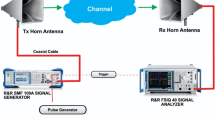Abstract
This paper describes the investigation and comparison of the accuracy of a deterministic model for a WLAN system in the indoor environment. The measurement system consisted of a spectrum analyzer and a log-periodic antenna. Non-line-of-sight (NLOS) propagation (in furnished rooms) was investigated. All the measurement sites mentioned in this paper are located in the Division of Information Technology at Universiti Putra Malaysia. The furnished rooms mentioned above were a teaching laboratory and a computer laboratory. The measured path losses were compared with the results obtained using deterministic models, namely the geometrical optics model and the uniform theory of diffraction model with the aid of image theory. The predicted results showed good agreement with the measured data for the NLOS environment, with an absolute mean error that ranged between 1.61 and 3.07 dB.
Similar content being viewed by others
References
Nešković, A., Nešković, N., & Paunović, D. (2000). Modern approaches in modeling of mobile radio systems propagation environment. In IEEE communications surveys, third quarter (pp. 2–12).
Ernst, B. In Digital mobile radio towards future generation systems: cost 231 final report: Tunnel, corridors, and other special environments (pp. 190–207). Austria: Technical University of Vienna.
Balanis C. A. (1989) Advanced engineering electromagnetics. John Wiley & Sons Inc, Canada
McNamara D. A., Pistorius C. W. I., Malherbe J. A. G. (1990) Introduction to the uniform geometrical theory of diffraction. Artech House, Boston
Remley K. A., Anderson H. R., Weisshar A. (2000) Improving the accuracy of ray-tracing techniques for indoor propagation modeling. IEEE Transactions on Vehicular Technology 49(6): 2350–2358
Kwok-Wai Cheung Sau J. H.-M., Murch R. D. (1998) A new empirical model for indoor propagation prediction. IEEE Transactions on Vehicular Technology 47(3): 996–1001
Valenzuela R. A., Landron O., Jacobs D. L. (1997) Estimating local mean signal strength of indoor multipath propagation. IEEE Transactions on Vehicular Technology 46(1): 203–212
Collonge S., Zaharia G., El Zein G. (2004) Influence of human activity on wide-band characteristics of the 60 GHz indoor radio channel. IEEE Transactions on Wireless Communication 3(6): 2396–2406
Tarng J. H., Liu T. R. (1999) Effective models in evaluating radio coverage on single floors of multi-floor buildings. IEEE Transactions on Vehicular Technology 48(3): 203–212
Author information
Authors and Affiliations
Corresponding author
Rights and permissions
About this article
Cite this article
Cheng, E.M., Abbas, Z., Fareq, M. et al. Comparative Study Between Measurement and Predictions Using Geometrical Optics and Uniform Theory of Diffraction for Case of Non-Line-of-Sight (NLOS) in Indoor Environment. Wireless Pers Commun 71, 2197–2213 (2013). https://doi.org/10.1007/s11277-012-0931-9
Published:
Issue Date:
DOI: https://doi.org/10.1007/s11277-012-0931-9




